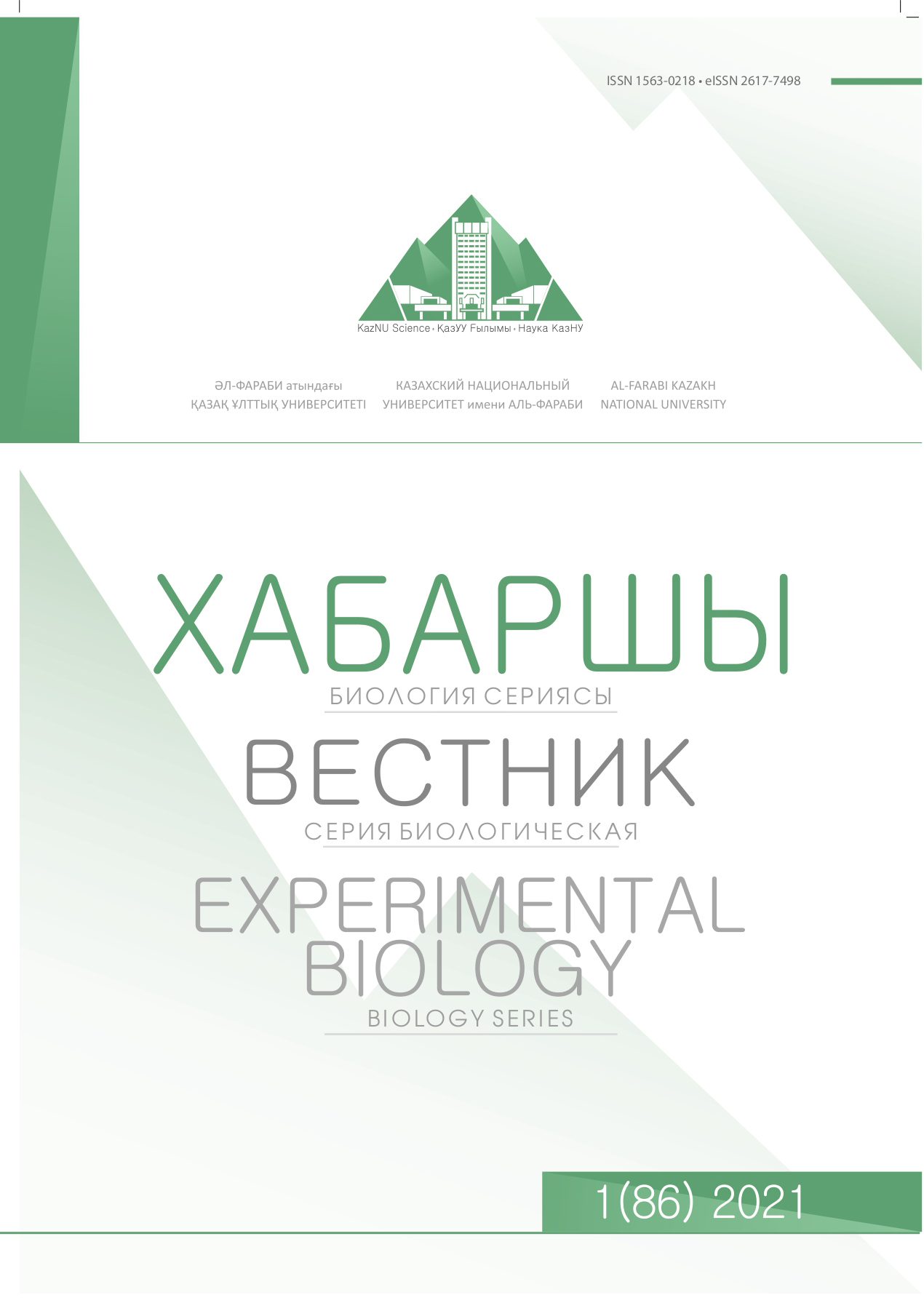EFFECTS OF SOIL PHYSICOCHEMICAL PROPERTIES ON BIODIVERSITY AND DISTRIBUTION OF SOIL INVERTEBRATES
DOI:
https://doi.org/10.26577/eb.2021.v86.i1.012Abstract
Soil invertebrates are bioindicators that characterize environmental changes due to high ecological
and species diversity, close contact with the soil, high sensitivity and rapid response to changes in
environmental parameters. This article presents the results of studies conducted in the biogeocenoses
of the foothills of the beyond Ile Alatau in the period from 2018 to 2020. The parameters that affect
the distribution and species composition of earthworms in various biogeocenoses are determined: soil
moisture, organic matter index and pH of the environment. The family Lumbricidae is widely distributed
in all biocenoses, although the predominant distribution is in the floodplain meadow. The humus
content in the soils of this biocenosis is 3.26±0.30%, and the humidity is 14.56±2.58%. As a result
of the study, 8 species of earthworms of the family Lumbricidae were identified, belonging to 5 genera:
Octolasium lacteum, Eisenia foetida, Eisenia nordenskioldi, Nicodrilus caliginosus, Nicodrilus longus,
Lumbricus rubellus, Lumbricus terrestris, Dendrobaena octaedra. The ratio of invertebrate groups in the
soil varies throughout the season. Earthworms are found in the soils of biogeocenoses from June to September. Changes in environmental conditions contribute not only to the distribution and diversity of soil
mesofauna, but also to their seasonal dynamics.
Key words: soil mesofauna, earthworm, foothills of the beyond Ile Alatau, biogeocenosis, physical and chemical parameters.
References
2 Samedov P.A. (1989) Vlijanie dozhdevyh chervej i mokric na fiziko-himicheskie i poverhnostnye svojstva pochv. Pochvovedenie. vol. 8, pp. 109-115.
3 Kurcheva G.F. (1971) Rol' pochvennyh zhivotnyh v razlozhenii i gumifikacii rastitel'nyh ostatkov. Moskva: Nauka, pp. 155.
4 Chauvat M., Ponge J.F., Wolters V. (2007) Humus structure during a spruce forest rotation: quantitative changes and relationship to soil biota. European Journal of Soil Science, vol.58, pp. 625 – 631.
5 Amosse J., Dozsa-Farkas K., Boros G., Rochat G., Sandoz G., Fournier B., et al. (2016) Patterns of earthworm, enchytraeid and nematode diversity and community structure in urban soils of different ages. European journal of soil biology, vol. 73, pp. 46–58.
6 Krivoluckij D.A. (1994) Pochvennaja fauna v jekologicheskom kontrole. Moskva: Nauka, 1994, pp. 269.
7 Lavelle P., Decaens T., Aubert M., Barot S., Blouin M., F.Bureau, et al. (2006) Soil invertebrates and ecosystem service. European journal of soil biology, vol. 42, no.1, pp. 3-15.
8 Hale C.M. (2008) Evidence for human-mediated dispersal of exotic earthworms: support for exploring strategies to limit further spread. Mol. Ecol., vol. 17, pp. 1165–1167.
9 Jouquet P., Dauber J., Lagerlof J., Lavelle P., Lepage M. (2006) Soil invertebrates as ecosystem engineers: Intended and accidental effects on soil and feedback loops. Applied Soil Ecology, vol. 32, no.2, pp.153-164.
10 Lavelle P. et al. (1997) Soil function in a changing world: the role of invertebrate ecosystem engineers. European journal of soil biology, vol. 33. pp. 159–193.
11 Deyn D., Raaijmakers G. B., Zoomer C. E., et. al. (2003) Soil invertebrate fauna enhances grassland succession and diversity. Nature, vol. 422. pp. 708-711.
12 Kozlovskaja L.S. (1976) Rol' bespozvonochnyh v transporte organicheskogo veshhestva bolotnyh pochv. Moskva: Nauka, 1976, pp. 214 .
13 Goncharov A.A. (2014) Struktura troficheskih nish v soobshhestvah pochvennyh bespozvonochnyh lesnyh jekosistem. Moskva: Institut problem jekologii i jevoljucii im. A.N. Severcova RAN, pp. 14.
14 Kurcheva G.F. (1971) Rol' pochvennyh zhivotnyh v razlozhenii i gumifikacii rastitel'nyh ostatkov. M.: Nauka, pp. 154
15 Joimel S., Cortet J., Jolivet C.C., Saby N.P., et al. (2016) Physico-chemical characteristics of topsoil for contrasted forest, agricultural, urban and industrial land uses in France. Sci. Total Environ., vol. 545, pp. 40–47.
16 Berthrong, S.T., Jobbagy E.G. (2009) A global meta-analysis of soil exchangeable cations, pH, carbon, and nitrogen with afforestation. Ecological Applications, vol. 19, pp. 2228–2241.
17 Jones E.L., Leather S.R. (2013) Invertebrates in urban areas: a review. EJE, vol.109, pp. 463–478.
18 Lavelle P. et al. (2006) Soil invertebrates and ecosystem services. European journal of soil biology, vol. 42, pp. 3–15.
19 Babenko A.S. (2013) Pochvennye bespozvonochnye kak indikatory sostojanija territorii. Tomsk, pp. 40.
20 Santorufo L., Gestel V., , Rocco A., Maisto G. (2013) Soil invertebrates as bioindicators of urban soil quality. Environ. Pollut., vol. 161, pp. 57–63.
21 Gel'cer Ju.G., Komovnikova T.N. (1979) Biologicheskaja aktivnost' lesnyh pochv. Genezis i jekologija pochv Central'nolesnogo gosudarstvennogo zapovednika. M.: Nauka, pp. 172 – 196.
22 Sokolova T.L. (2010) Diagnosticheskie vozmozhnosti pochvennoj mezofauny. Vestnik Kostromskoj gosudarstvennyj universitet im.N.A. Nekrasova, no.3, pp. 13-14.
23 Giljarov M.S. (1985) Zoologicheskij metod diagnostiki pochv. Moskva: Nauka, pp. 277.
24 Giljarov M.S. (1978) Rol' pochvennyh zhivotnyh v razlozhenii rastitel'nyh ostatkov i krugovorote veshhestv. M.S. Giljarov, B.R. Striganova. Itogi nauki i tehniki. Zoologija bespozvonochnyh. M.: VINITI, no. 5, pp. 69.
25 Matveeva D.G. (1982) Dozhdevye chervi semejstva Lumbricidae Moskovskoj oblasti. Pochvennye bespozvonochnye Moskovskoj oblasti. D.G. Matveeva, T.S. Perel'. M.: Nauka, pp. 133-143.
26 Chekanovskaja O.V. (1960) Dozhdevye chervi i pochvoobrazovanie. M.: Nauka, pp. 208.
27 Smetak, K. M., Johnson-Maynard J.L., Lloyd, J.E. (2007) Earthworm population density and diversity in different-aged urban systems. Appl. Soil Ecol., vol. 37, pp. 161–168.












